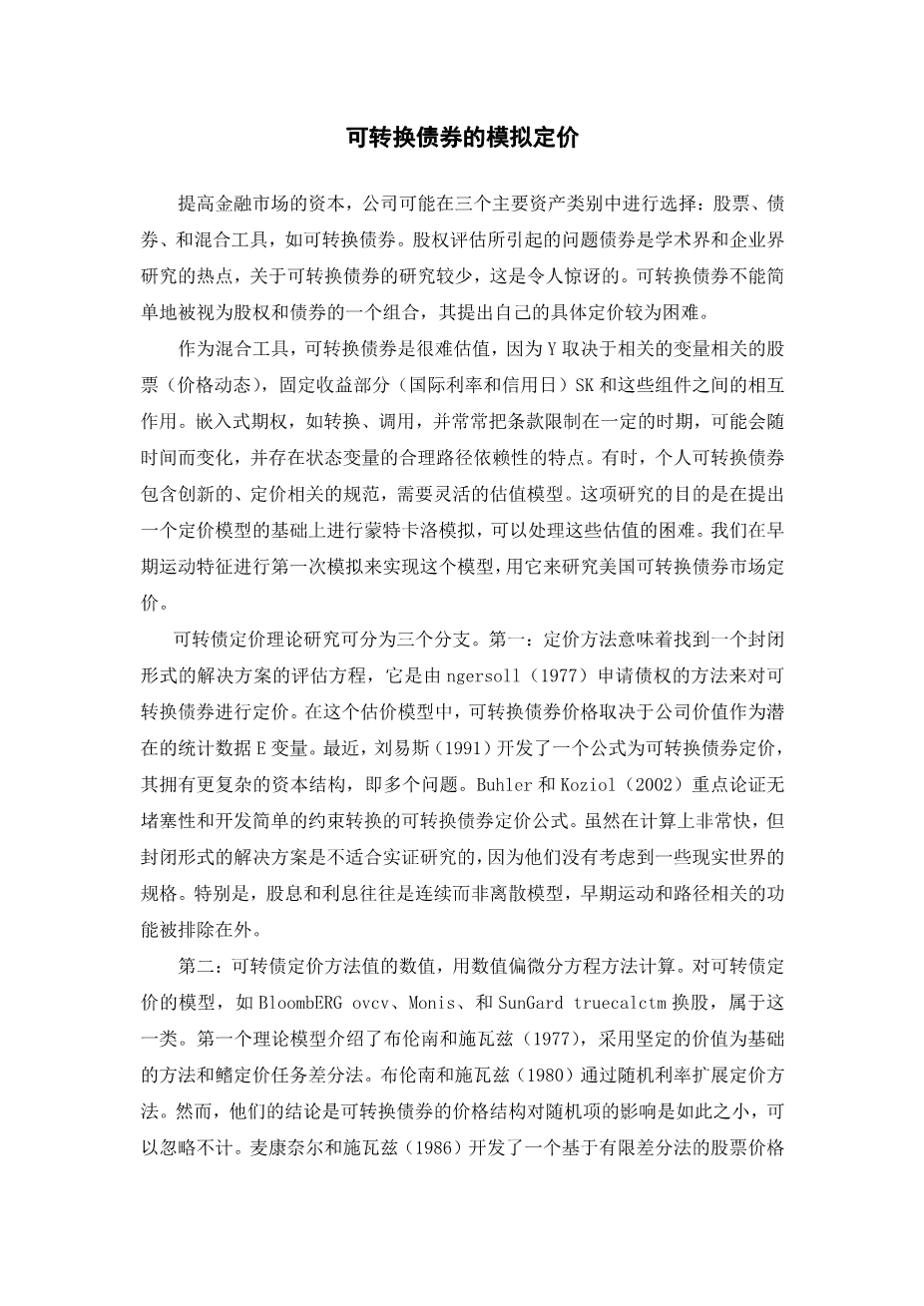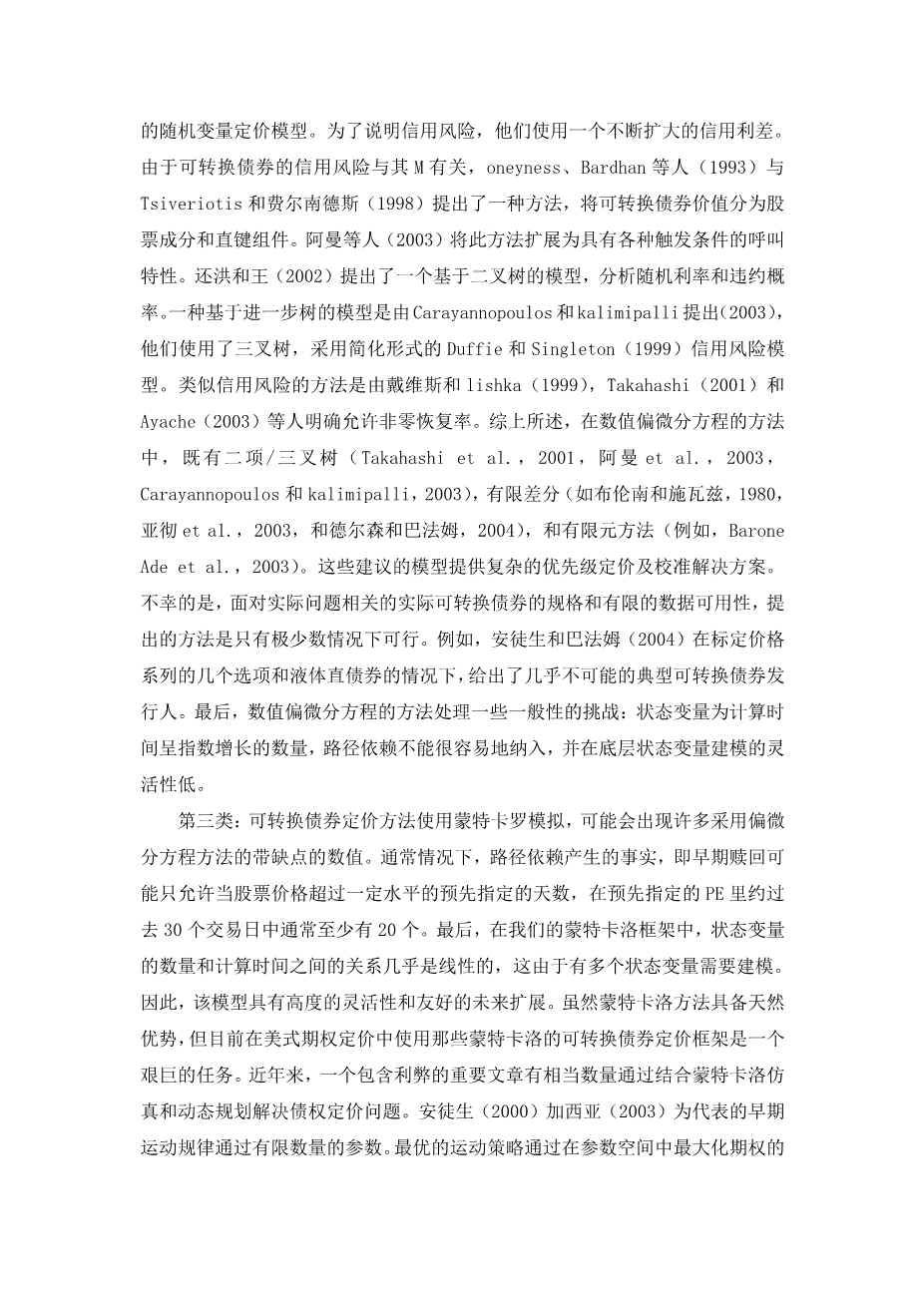Simulation-Based Pricing of Convertible Bonds
Manuel Ammann, Axel Kind, Christian Wilde
University of St.Gallen / Goethe University Frankfurt
Abstract
We propose and empirically study a pricing model for convertible bonds based on Monte Carlo simulation. The method uses parametric representations of the early exer-cise decisions and consists of two stages. Pricing convertible bonds with the proposed Monte Carlo approach allows us to better capture both the dynamics of the underlying state variables and the rich set of real-world convertible bond specificatio ns. Further-more, using the simulation model proposed, we present an empirical pricing study of the US market, using 32 convertible bonds and 69 months of daily market prices. Our results do not confirm the evidence of previous studies that market prices of co nvertible bonds are on average lower than prices generated by a theoretical model. Similarly, our study is not supportive of a strong positive relationship between moneyness and mean pricing error, as argued in the literature.
JEL codes: G13, G14
Keywords: Convertible bonds, Pricing, American Options, Monte Carlo simulation
This project is supported by the Swiss National Science Foundation. We are grateful for comments of Giovanni Barone-Adesi, Murray Carlson, Robert Engle, Stephen Figlewski, Fabio Mercurio, Suresh Sundaresan, Ingo Walter, Heinz Zimmermann, and participants of the Northern Finance Association Conference in Banff, Canada, the Quantitative Methods in Finance Conference in Cairns, Australia, the Australasian Finance and Banking Conference in Sydney, Australia, and of Research Seminars at WHU in Koblenz, Germany, University of Zurich,¨ Switzerland, University of Konstanz, Germany, and Goethe University in Frankfurt, Germany. We thank Mace Advisers for providing access to the Mace Advisers convertible bond database. We acknowledge Zeno Durr,¨ Mark Evans, and Peter Hall for their assistance in obtaining the data and for helpful discussions. Manuel Ammann and Axel Kind are at the Swiss Institute of Banking and Finance, University of St.Gallen. Christian Wilde is at the Finance Department, Johann Wolfgang Goethe University Frankfurt. Email addresses: manuel.ammann@unisg.ch, axel.kind@unisg.ch, and wilde@finance.uni-frankfurt.de.
Simulation-Based Pricing of Convertible Bonds
Abstract
We propose and empirically study a pricing model for convertible bonds based on Monte Carlo simu-lation. The method uses parametric representations of the early exercise decisions and consists of two stages. Pricing convertible bonds with the proposed Monte Carlo approach allows us to better capture both the dynamics of the underlying state variables and the rich set of real-world convertible bond spec-ifications. Furthermore, using the simulation model proposed, we present a n empirical pricing study of the US market, using 32 convertible bonds and 69 months of daily market prices. Our results do not confirm the evidence of previous studies that market prices of convertib le bonds are on average lower than prices generated by a theoretical model. Similarly, our study is not supportive of a strong positive relationship between moneyness and mean pricing error, as argued in the literature.
1. Introduction
To raise capital on financial markets, companies may choose among three majo r asset classes: equity, bonds, and hybrid instruments, such as convertible bonds. While issues arising from valuing equity and bonds are extensively studied by researchers in academia and industry, fewer articles focus on convertible bonds. This is surprising as convertible bonds cannot simply be considered as a combination of equity and bonds but present their own specific pricing challenges.
As hybrid instruments, convertible bonds are difficult to value because the y depend on variables related to the underlying stock (price dynamics), the fixed income part (inter est rates and credit risk), and the interaction between these components. Embedded options, such as conversion, call, and put provisions often are restricted to certain periods, may vary over time, and are subject to additional path-dependent features of the state variables. Sometimes, individual convertible bonds contain innovative, pricing-relevant specifications that require flexible valuation models. The purpose of this study is to present a pricing model based on Monte Carlo Simulation that can deal with these valuation challenges.
We implement this model and use it to perform the first simulation-based pricing s tudy of the US convertible-bond market that accounts for early-exercise features.
Theoretical research on convertible bond pricing can be divided into three branches. The first pricing approach implies finding a closed-form solution to the valuation equatio n. It was initiated by Ingersoll (1977a), who applies the contingent claims approach to the valuation of convertible bonds. In this valuation model, the convertible-bond price depends on the firm value as the underlying state variable. More recently, Lewis (1991) develops a formula for convertible bonds that accounts for more complex capital structures, i.e. multiple issues. Buhler¨ and Koziol (2002) focus on the possibility of non-block-constrained conversion and develop pricing formulas for simple convertible bonds. While very fast in computation, closed-form solutions are not suitable for empirical studies because they fail to account for a number of real-world specifications. Especially, di vidends and coupon payments are often modeled continuously rather than discretely, early-exercise features are omitted, and path-dependent features are excluded.
The second pricing approach values convertible bonds numerically, using numerical partial dif-ferential equation approaches. Commercially available models for
剩余内容已隐藏,支付完成后下载完整资料


英语译文共 5 页,剩余内容已隐藏,支付完成后下载完整资料
资料编号:[485883],资料为PDF文档或Word文档,PDF文档可免费转换为Word
以上是毕业论文外文翻译,课题毕业论文、任务书、文献综述、开题报告、程序设计、图纸设计等资料可联系客服协助查找。


